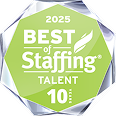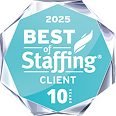Employee onboarding is crucial. If you don’t orient your new employees properly, you risk having them waste time trying to figure out their roles. Without clarity on their job duties and company procedures, they won’t only be inefficient; they’ll get incredibly frustrated. They might even quit. And who can blame them? Who’d want to work in a place where you don’t feel entirely welcome or competent? Here are three steps for an effective onboarding process to ensure you don’t waste time and money when bringing in a new hire.
An essential part of a successful company’s recruitment process is its onboarding strategy.
Onboarding Best Practices
A successful employee onboarding process helps new hires feel welcomed, prepared, and ready for long-term success.
What are the three 3 phases of employee onboarding? The three steps of successful onboarding are preparing the workplace before the new employee’s first day, implementing a structured orientation program, and following up with check-ins and ongoing support.
Prepare Workplace For New Employee’s First Day
Your company should begin preparing for the candidate’s first day of work before they arrive. Have an orientation process and paperwork already in place. Let the new hire know what they can expect in their first weeks and months. Communication is essential, and it should include an introductory meeting to outline their responsibilities and who they can speak to if they have questions. If they fill out paperwork beforehand, they can focus on their professional duties and social integration once they arrive. Procure office equipment if needed.
Implement a Structured Orientation Program
On day one, give the new employee their onboarding welcome package. Introduce them to their supervisor and other team members. Provide training about the company’s products, services, clients, and other vital knowledge and skills. The new employee should receive the company handbook of policies and procedures.
New employees must understand their roles to feel comfortable, competent, and armed for success. Instead of just handing them a list of tasks and responsibilities, each employee should understand how their duties contribute to the success of the company as a whole. A well-integrated employee will be more productive and effective. Tell them your expectations for this role and how they can get there. It’s essential to develop the employee-manager relationship early. Their manager is the one who will teach them, guide them, encourage them, and empower them.
Follow Up With Check-Ins and Ongoing Support
A manager should communicate immediately what they expect from their new hire and how they prefer to communicate. They should ask questions to ensure the employee understands and learns about their new role. Schedule meetings during the first week, at the end of two weeks, and again monthly and quarterly to check progress and offer feedback to the employee. They should understand that their development is vital to the company, expect constructive analysis, and be allowed to ask questions and offer comments.
Sometimes, new employees struggle with their jobs or leave the company because they don’t feel comfortable in the culture. Reach out before they start the job to make them feel welcome, emotionally connected, and bonded to new co-workers. In addition to your company’s mission and core values, communicate your brand as much as possible in an orientation program.
Be patient with onboarding so you don’t risk having the employee continue with bad habits or quit altogether. A new employee is only a clean slate once! After that, it takes more time and effort to unlearn something they have misunderstood. They may have damaged your company’s efficiency and reputation by that time. You also risk losing them, meaning you’d have to begin the recruitment process again.
Robust New Hire Onboarding for Maximum Success
How would you ensure a successful employee onboarding process? Collaborate with experienced professionals who can advise you on best practices for hiring and onboarding. CulverCareers helps you get the right people hired quickly, and we also help you develop those new employees into valuable team members.
Our talent acquisition team works closely with organizations to find the best candidates with experience in your industry so they can hit the ground running. Our extensive professional network includes passive candidates currently working in the role who may be open to new opportunities.
Integrate new talent with CulverCareers, a leading recruitment agency. Contact us to schedule a consultation.






